Subscribe now to get notified about IU Jharkhand journal updates!
Influence of observational experience of Public service advertising of Health care service
Abstract :
Public service advertising related to health care service sector like Dengue, Women health, Smoking, Swine Flu, HIV / AIDS, Don’t drink and drive, Anti-Alcohol, Cancer, Polio, Typhoid, Thalassemia, Drinking and smoking, Family Planning, Malaria, Iodine salt, Immunization for kids in government hospital etc. regularly carried out by the Government. To promote these philanthropic causes government spends lot of money every year but it need to be measure that actually these advertisement may influence or not. Hence, in this context this study is an attempt to examine the influence of observational experience of Public service advertising of Health care service Sector in Tripura, India. This study is mainly based on the primary and secondary data. Percentage analysis through table, pie-chart, bar diagram, Chi square test, Phi, Cramer's V Value and multiple stepwise logistic forward regressions were applied. However, from the whole analysis of the study it can be strongly conclude that the influence of observational experience of Public service advertising of Health care service Sector in Tripura, India is very strong and effective. It is also observed that the study have provided positive outcome and further expansion of field study frequently basis may give more effective and efficient social wellbeing’s even during the COVID – 19 Pandemic to cover the effectiveness of promotional campaign carried out by Government of India for COVID – 19 Pandemic.
Keywords :
Public, Health, Advertising, Factors and Observation1. Introduction
Management of the economics of public service advertising of health care service sector shall be followed very efficiently and effectively by any nation proactive to human beings or society in general. In public health promotion activities Public service advertising is used to inform the public on issues that are frequently considered to be in the general best interests of the community at large. Typically, it reflects a social well being, philosophical theory and humanitarian notion. It is also commonly referred to as a public service announcement (PSA) or a community service announcement (CSA). The ads are usually broadcast on radio or television, but may also appear in newspapers or magazines. Public service advertising is commonly aimed at altering public attitudes by raising consciousness about particular issues. The public service advertising campaigns are often sponsored by government, trade associations, civic organizations, non-profit institutions or religious groups.
Research Gaps: It can be seen from the review of literatures related to the Influence of observational experience of Public service advertising of Health care service Sector in Tripura, India, that no study has been conducted on these aspects in the state of Tripura. Hence, present study having in depth of Influence of observational experience of Public service advertising of Health care service Sector in Tripura, India state perspectives covering various aspects of Influence of observational experience of Public service advertising of Health care service Sector in Tripura, India is very significant for sustainable development of inequities in health outcomes.
Objective of the Study:
The research works is an attempt to investigate the following objective:
- To study the Influence of observational experience of Public service advertising of Health care service Sector in Tripura, India.
- To study the relationship between general socio-economic characteristics of respondents and overall health care service sector related public service advertising observation experiences in the study area.
- To study the relationship between general socio-economic characteristics of respondents and the influence of observational experience through electronic, print and outdoor media of Public service advertising of Health care service Sector in the study area
Methodology:
This study is mainly based on the primary and secondary data. Primary data collected through pre-tested questionnaire with sample size 240 covering all districts in Tripura and secondary data collected from the various sources like Published report, Web Articles, Journals and research report etc. Comparative study for this research have been done through the assessment of existing research report, articles related to the literature for the factors influencing observational experience public service advertising of health care service sector. Percentage analysis through table, pie-chart, bar diagram, Chi square , Phi, Cramer's V & multiple stepwise logistic forward regressions were applied to test the research hypothesis with the help of SPSS.
Formulation of hypotheses:
Based on the objectives of thesis, the following main hypotheses were formulated to know the association between overall health care service sector related public service advertising observation experiences and general socio-economic characteristics of respondents in the study area.
A. There is relationship between general socio-economic characteristics of respondents and overall health care service sector related public service advertising observation experiences in the study area (are associated).
B. There is relationship between general socio-economic characteristics of respondents and the influence of observational experience through electronic, print and outdoor media of Public service advertising of Health care service Sector in the study area(are associated).
Research Questions:
The research questions for the research works are as follows:
What influence of observational experiences through electronic, print and outdoor media of Public service advertising of Health care service Sector?
Literature Review:
In order to build up a appropriate perception of the research problem recognition and to expand a theoretical structure to carry out the assessment of existing literature for the economics of public service advertising of health care service sector from the secondary sources, the following literature have been reviewed.
Potter, A., Jardine,A., Morrissey,A., & Lindsay, M.D.A.( 2019) outcome of the study display that Fight the Bite communication campaign importantly increased awareness and anticipation practices among the respondents who were involved in the campaign or research.
Schwartz, L M., Woloshin, S., (2019) works reveals that medical marketing rose significantly from 1997 to 2016, particularly direct to consumer (DTC) public service advertising for drugs and health services. Pharmaceutical related public service advertising to health professionals caused prime expenditure and proves high even with innovative policy linked to industry influence. In spite of the raise in marketing over 20 years, authoritarian control remains limited.
Ahmed, W., Bath, P.A., Sbaffi, L. et al., Demartini, G. (2018) revels that mass media public awareness campaigns are very old techniques for increasing public awareness in order to build constructive behaviors and beliefs. Moreover, recent trend on social media like Twitter are effective enough to provide an alternative route for increasing normal and specific awareness. The study finds out that to what extent Twitter can increase the awareness among the users about Autism on World Autism Awareness Day. For this purpose study collected over 2,315,283 tweets in two-month duration. It was found that the autism awareness campaign was highly successful on Twitter as because numbers of tweets and positive attitudes were observed in the study period.
Bordarie, J., (2018) works outcomes validate the importance of using social marketing and communication in order to change social perceptions towards public policies. Based on the social message and cause an outcome also varies. Research analyses draw attention for using social awareness campaign for building strong social representation and social marketing.
Henley W.H. et al. (2018) worked on improving effectiveness of public service advertisements to prevent texting and driving of American youth and their results point out that authoritarian spotlight ads (promotion focus in a texting and donation context) have a positive effect on attitude toward the ads. Results also point toward that a regulatory focus ad (avoidance spotlight) by means of an interactive release technique has a constructive result on behavioral purposes. Accomplishment purposes examination also specify positive outcomes for behavior from Public service advertisement.
Mansour,D., Nashwan,A., Rasheed,H.,A., Hararah,M., Nassar.,H., Abbas,R.,A., Alnuaimi,M., Mrayat,B.,( 2018) published report reveals that use of different social media message is different based on demographic profile of the people like based on age, education and socioeconomic groups etc., hence breast cancer public awareness campaign using various social media should be customized based on demographic profile of the target group. The study also indicates that public awareness campaign in the GCC still regard as important challenge due to different culture and language problems.
Data Analysis - Background:
This part mainly deals with the socio economic profile of the 240 sample respondents from all districts in Tripura, India. It is based on the analysis of field level study data collected in the year 2017 and 2018. As stated earlier, all districts in Tripura, India namely West Tripura district, Sipahijala district, Dhalai district, North Tripura district, Gomati district, Khowai district, Unakoti district, and South Tripura district were selected for the study. As the study is focused on the effectiveness of the economics of the selected public service advertising of health care service sector in Tripura, India covering the area or subject matter like the effectiveness of the economics of selected health care service sector related public service outdoors advertising, influence of health care service sector related public service television advertising in electronic media and its effect in pursuing the announcement made for public cause in Tripura, influence of health care service sector related public service print media advertising and its effect in pursuing the announcement made for public cause in Tripura, overall reach of the recent government sponsored health care service sector related public service advertising among public in Tripura and right media for telecasting the health care service sector related public service advertising to make it more effective, hence in this regard collection of the socio economic profile sample respondents are essential. Further, sixteen demographic variables and socio-economic characteristics of respondents considered for the study are gender of the respondents, age of the respondents, education, category or caste, nature of family, occupational status, marital status, resident location, Public service advertising observation experiences related to advertising on health care service sector, Health care service sector related public service advertisement telecasted in television observation experiences, Health care service sector related public service advertising published in the print media observation experiences, health care service sector related public service advertising given in outdoor media observation experiences, family monthly income, annual expenditure, land ownership in area and types of property holding has been discussed here.
1. Gender of the Respondents:
The Table 1 specifies that, most of the respondents were male married (37.1%) and unmarried (33.3%). The percentage of the female married and female unmarried was 15.4 percent and 12.9 percent respectively. The percentage of the Transgender and Widow was 0.4 percent each.
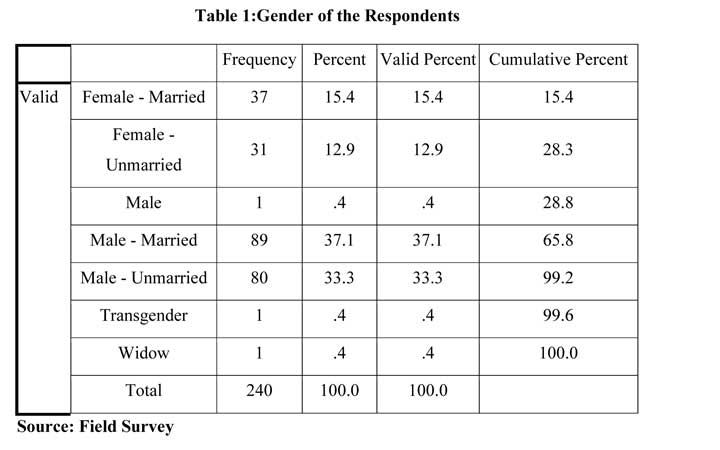
2. Age of the Respondents:
The Table 2 specifies that, most of the respondents covered in the research work were young respondents between 18 to 30 years age group (44.6 %), followed by middle aged between 31 to 50 years age group were 35.4 percent. The percentage of Old (Above 51 years) respondents engaged in survey was reasonably very less (20.0 %).
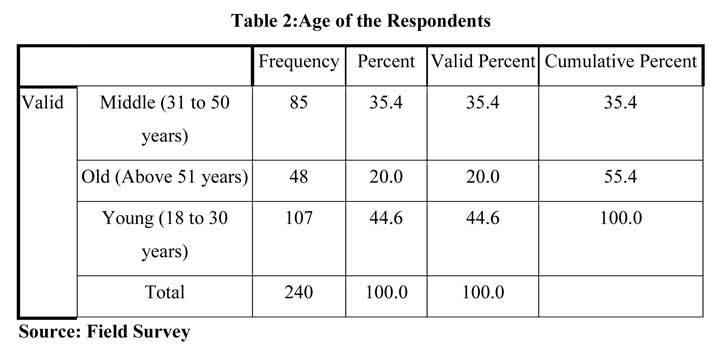
Source: Field Survey
3. Education or Literacy Status of the Respondents:
From the Table 3, it reveals that nearly 34.6% of the respondents had received educated up to graduation level. 32.5 percent of the respondents had received Post graduation level education. 17.5 percent of the respondents had received Undergraduate level education. 9.6 percent of the respondents had received High school (11 to 12) level education. 2.9 percent of the respondents had received Secondary/ Middle school (6 to 10) level education. 2.1 percent of the respondents had received Doctorate level education.0.8 percent of the respondents had received Primary school (Up to 5) level education. In total, practically 69.2 percent of the respondents had received graduation and above level of education out of the total 240 respondents.
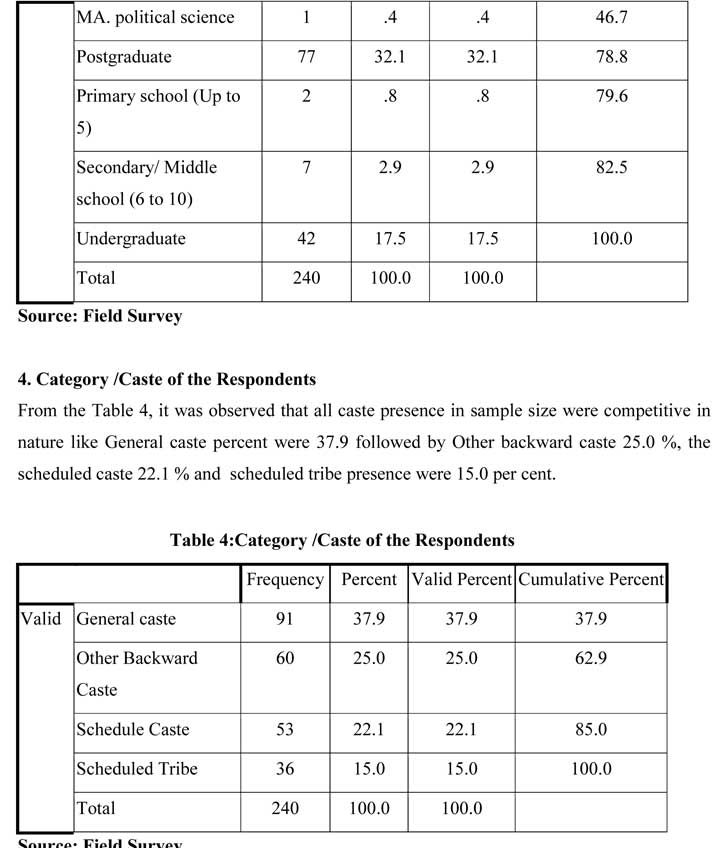
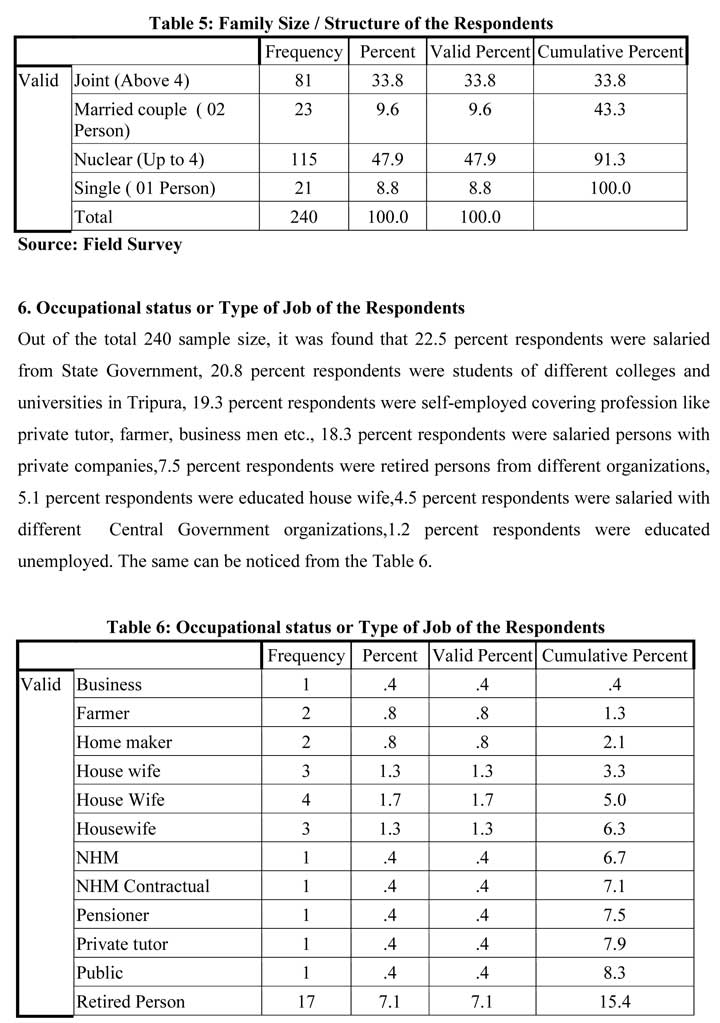
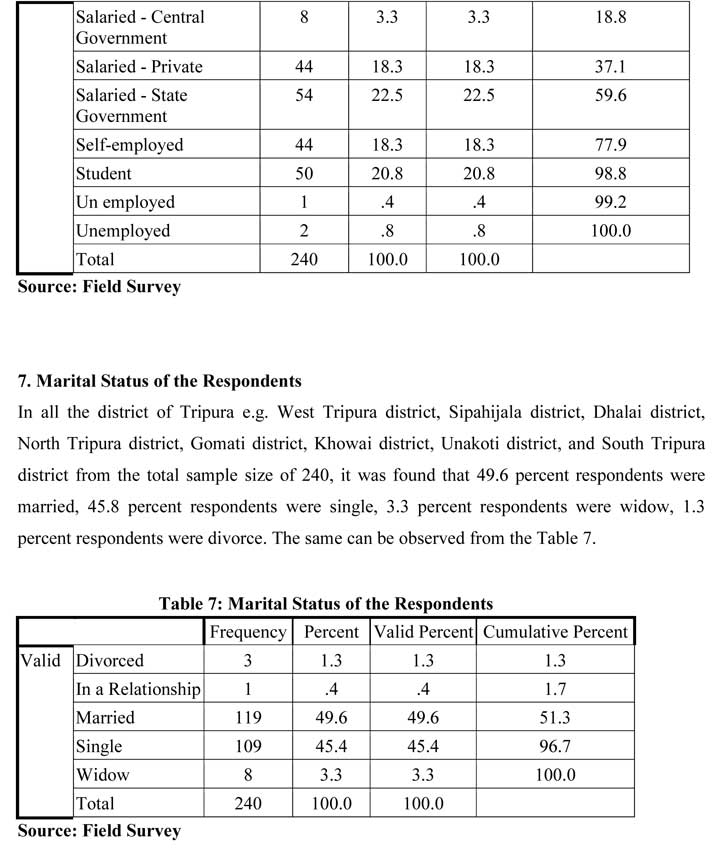
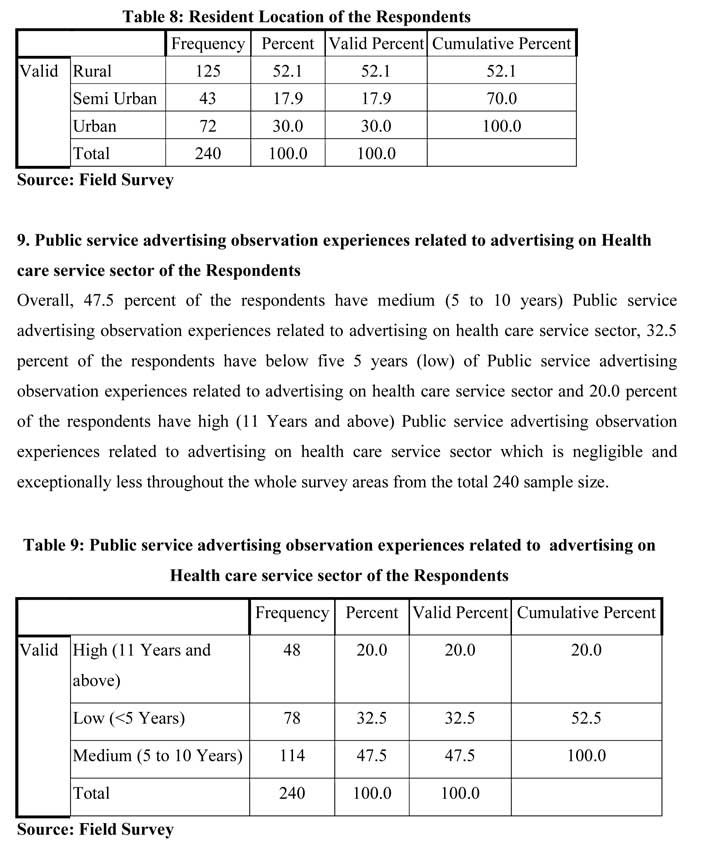
Source: Field Survey
10. Health care service sector related public service advertisement telecasted in television observation experiences of the Respondents:
In health care service sector related public service advertisement telecasted in television observation experiences throughout the all study areas respondents have Medium (5 to 10 Years) observation experiences which is 42.9 percent, Low ( < 5 Years) observation experiences of health care service sector related public service advertisement telecasted in television is 32.5 percent and High (11 Years and above) observation experiences of health care service sector related public service advertisement telecasted in television is 24.6 percent.
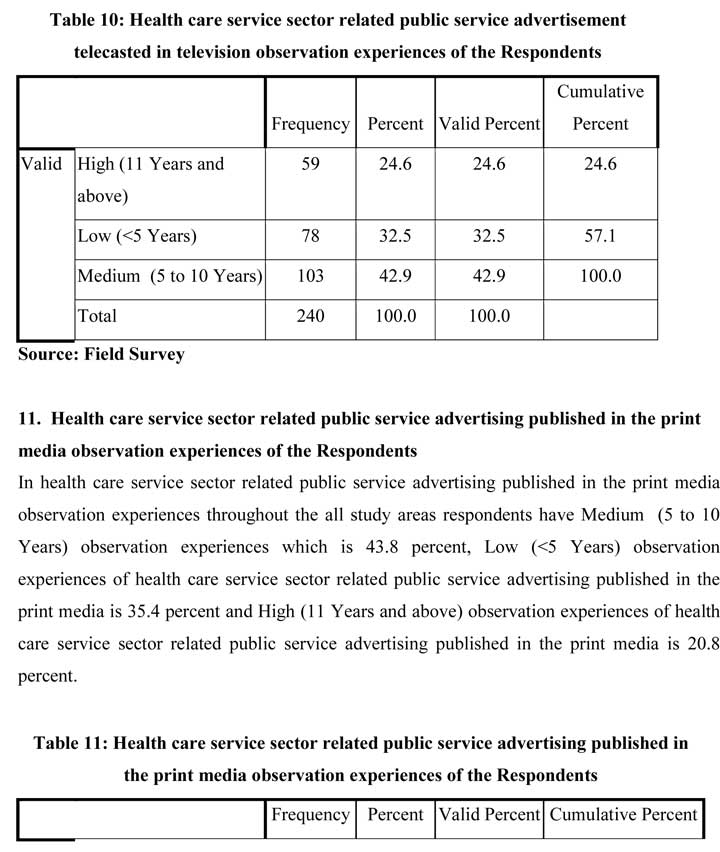
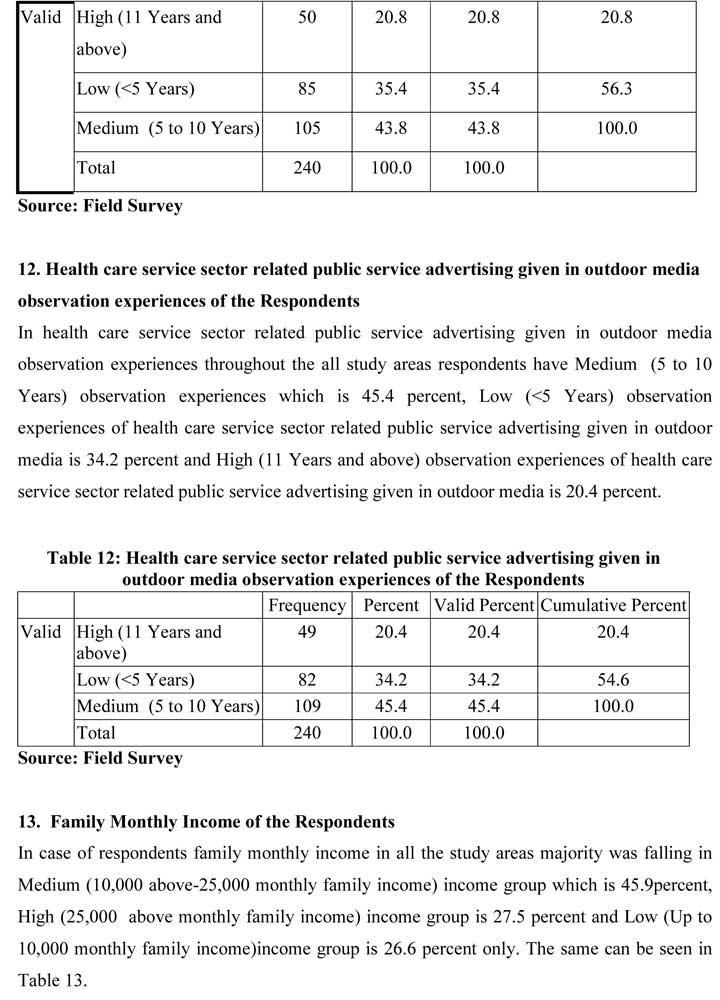
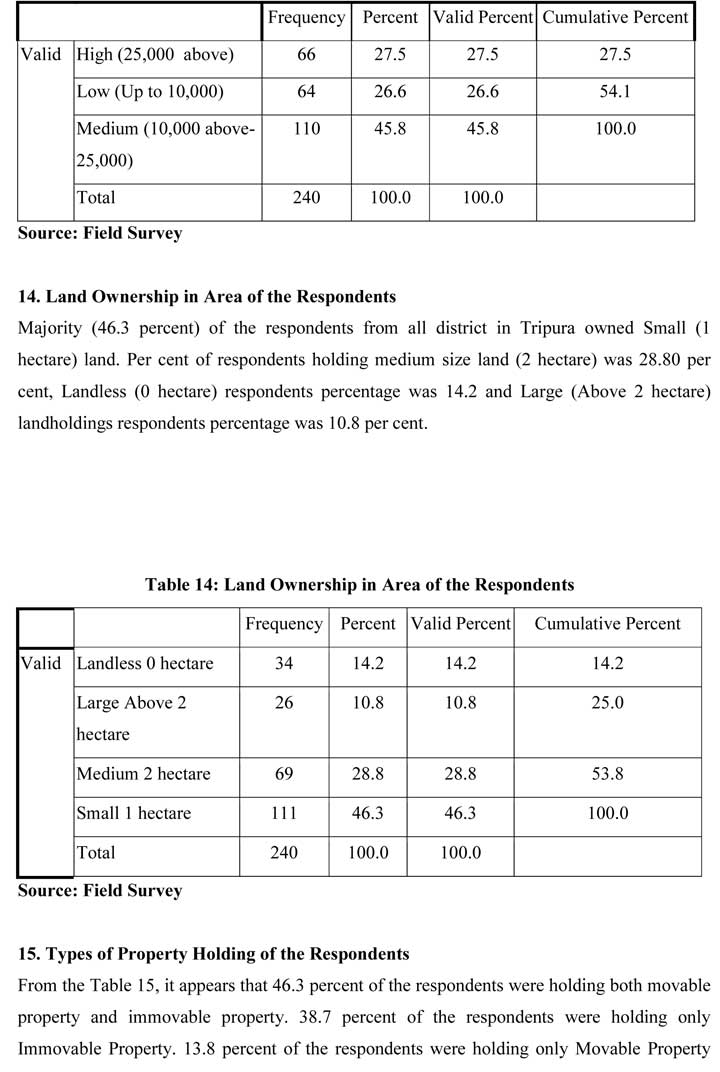
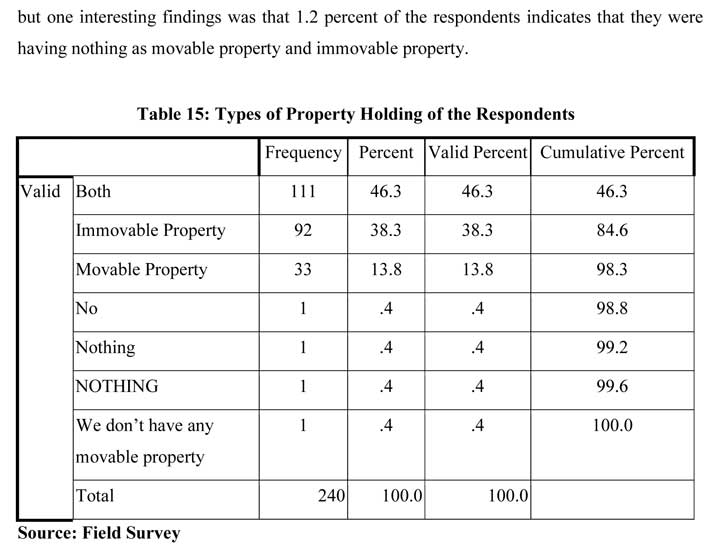
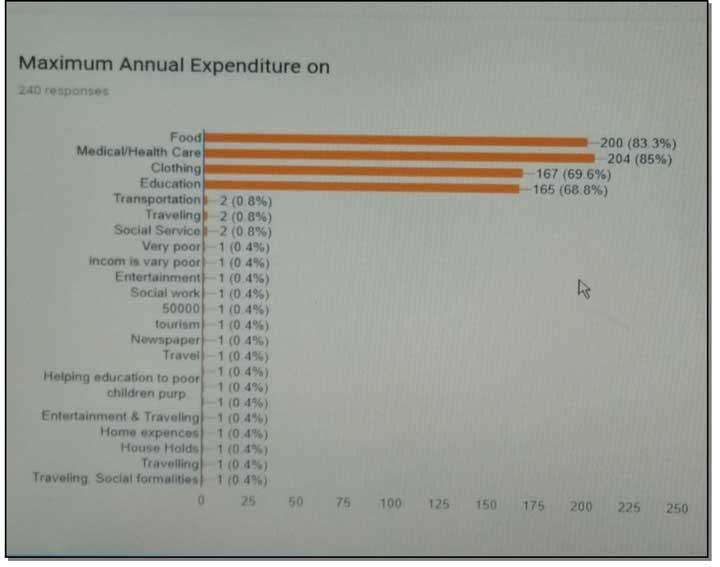
Source: Field Survey
16. Maximum Annual Expenditure on
From the Figure 16 on maximum annual expenditure, it very clearly emerge that the respondents maximum expenditure takes places on medical or health care issues which was 85 percent. 83.3 percent expenditure takes places for food purpose, 69.6 percent expenditure takes places for clothing and 68.8 percent expenditure takes places for education. Apart from these expenditures, 2.00 percent expenditure takes places on transportation,travelling and social service etc. Again 1.00 percent expenditure takes places on expenditure headings like tourism,newspaper, household items, helping poor for education etc. But it was observed that maximum annual expenditure takes places medical or health care issues.
Hypotheses analysis:
The important demographic profile and socio-economic characteristics data of the 240 respondents from all eight districts which were corresponding to Gender of the respondents, Age of the respondents, Education or Literacy Status, Occupational status or Type of Job, Family Monthly income, Land Ownership in Area and Types of Property Holding were cross-tabulated [Chi square with the four main nature of observation of Public service advertising observation experiences of the respondents related to advertising on Health care service sector, Health care service sector related public service advertisement telecasted in television observation experiences of the respondents, Health care service sector related public service advertising published in the print media observation experiences of the respondents and Health care service sector related public service advertising given in outdoor media observation experiences of the respondents. For this purpose, Chi square tests of independence were used. These tests establish whether two or more attributes are associated or not. The calculated value of Chi square was compared at 5% (0.05) level of significance. If the p value is less than the alpha value (0.05) then null hypotheses is rejected i.e. the attributes are associated or related but if the p value is greater than the alpha value (0.05) then alternative hypothesis is accepted i.e. the attributes are not associated or related. The phi coefficient ranges from 0 to 1 with smaller relationships being closer to 0 and larger relationships being closer to 1. Like the phi coefficient, Cramér’s V statistic ranges from 0 to 1, with higher values indicating larger strengths of associations, or effect sizes. Hence, Phi & Cramer's V were calculated to know the effectiveness, as the research objective is to examine the effectiveness of public service advertising related to advertising on health care service sector.

Source: Field Survey
Interpretation: Table 16 depicts that all the selected demographic profile and socio-economic characteristics like Gender of the respondents, Age of the respondents, Education or Literacy Status, Occupational status or Type of Job, Family Monthly income, Land Ownership in Area and Types of Property Holding are significantly related or associated with Public service advertising observation experiences of the respondents related to advertising on Health care service sector. From the Table 16, it also appears that the strengths of associations or effect or Influence sizes are very strong, strong and positive.
Multiple stepwise forward logistic regressions analysis:
Data were analyzed using multiple stepwise logistic forward regressions (PROC LOGISTIC; SAS, 2012) to do the stepwise selection for identifying the prognostic factors for Public Service Advertising Observation Experiences (oe) related to Advertising on Health Care Service Sector. The model used was the logistic regression (LR) model:
sector.

where, Public Service Advertising Observation Experiences related to Advertising on Health Care Service score is the dependent variable; gender, age, educational qualification and other variables are the predictor variables that ‘x’ represents; = intercept of the model and = the coefficient of predictor variables. LR enters predictor variables in a stepwise manner; it will also fit specified models or perform forward selection of variables. At each step in the stepping process, an attempt was made to remove any insignificant variables from the model before adding a significant variable to the model. A significance level of 0.3 was required to allow a variable to enter into the model, and a significance level of 0.35 was required for a variable to stay in the model. The step selection was based on the maximum likelihood ratio. The evaluation of the logistic regression model was done by Hosmer and Lemeshow Goodness-of-Fit Test in the logistic procedure. The response variable chooses observational experience = 1 (when the score is high) as against observational experience = 0 (when the score is low) so that the probability of observational experience score is modeled.
Interpretation: From stepwise logistic regressions, some variables like Advertising published in the tele media, Advertising published in the outdoor media, age of respondents were emerged as the prognostic factors that could influence observational experience significantly. The result of stepwise logistic regression analysis is presented in Table 17 that shows the factors influencing observational experience.
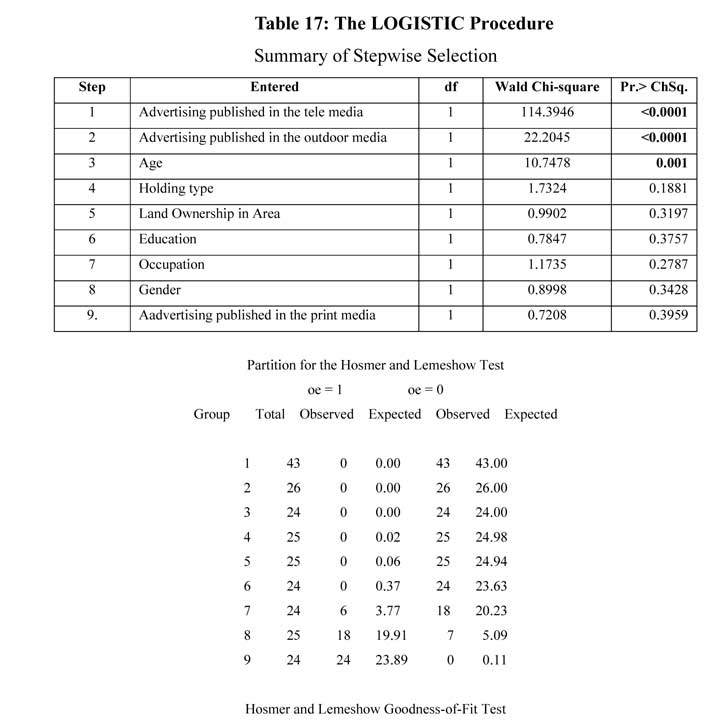
Findings, Summarizations and Concluding Observation:
Overall, 47.5 percent of the respondents have medium (5 to 10 years) Public service advertising observation experiences related to advertising on health care service sector, 32.5 percent of the respondents have below five 5 years (low) of Public service advertising observation experiences related to advertising on health care service sector and 20.0 percent of the respondents have high (11 Years and above) Public service advertising observation experiences related to advertising on health care service sector which is negligible and exceptionally less throughout the whole survey areas from the total 240 sample size. In health care service sector related public service advertisement telecasted in television observation experiences throughout the all study areas respondents have Medium (5 to 10 Years) observation experiences which is 42.9 percent, Low (< 5 Years) observation experiences of health care service sector related public service advertisement telecasted in television is 32.5 percent and High (11 Years and above) observation experiences of health care service sector related public service advertisement telecasted in television is 24.6 percent. In health care service sector related public service advertising published in the print media observation experiences throughout the all study areas respondents have Medium (5 to 10 Years) observation experiences which is 43.8 percent, Low (< 5 Years) observation experiences of health care service sector related public service advertising published in the print media is 35.4 percent and High (11 Years and above) observation experiences of health care service sector related public service advertising published in the print media is 20.8 percent. In health care service sector related public service advertising given in outdoor media observation experiences throughout the all study areas respondents have Medium (5 to 10 Years) observation experiences which is 45.4 percent, Low (< 5 Years) observation experiences of health care service sector related public service advertising given in outdoor media is 34.2 percent and High (11 Years and above) observation experiences of health care service sector related public service advertising given in outdoor media is 20.4 percent. Table 16 depicts that all the selected demographic profile and socio-economic characteristics like Gender of the respondents, Age of the respondents, Education or Literacy Status, Occupational status or Type of Job, Family Monthly income, Land Ownership in Area and Types of Property Holding are significantly related or associated with Public service advertising observation experiences of the respondents related to advertising on Health care service sector. From the Table 16, it also appears that the strengths of associations or effect or Influence sizes are very strong, strong and positive. From stepwise logistic regressions, some variables were emerged as the prognostic factors that could influence observational experience significantly. The result of stepwise logistic regression analysis is presented in Table 17 that shows the factors influencing observational experience. Hence, from the whole analysis of the study it can be strongly conclude that the Influence of observational experience of public service advertising related to advertising on health care service sector is effective and it is observed that the study have provided positive outcome and further expansion of field study frequently basis may give more effective and efficient social wellbeing’s.
References
- Ahmed, W., Bath, P.A., Sbaffi, L. et al., Demartini, G. (2018). Measuring the effect of public health campaigns on Twitter: the case of World Autism Awareness Day. In: Transforming Digital Worlds. iConference 2018: Transforming Digital Worlds, 25-28 Mar 2018, Sheffield, UK. Lecture Notes in Computer Science. Springer Verlag, pp. 10-16. http://eprints.whiterose.ac.uk/127215/ (Accessed & Retrieved on 26/06/2019 at 12.12pm)https://doi.org/10.1007/978-3-319-78105-1_2.
- Bordarie, J., (2018). Social representations and social marketing: Effectiveness of awareness campaigns on the representation of public policies? International Journal of Nonprofit and Voluntary Sector marketing.24:2. https://doi.org/10.1002/nvsm.1633 (Accessed & Retrieved on 14/06/2019 at 5.56 pm) https://onlinelibrary.wiley.com/doi/abs/10.1002/nvsm.1633
- Datta,D., Choudhury , A.K. (2017).The economics of public service advertising of health care service sector – A Literature Review. International Journal of Research in Commerce, Economics & Management.7 (10).15-18. ISSN: 2231-4245. UGC Approved Journal No: 7515.
- Datta,D., Choudhury , A.K. (2019).Effectiveness of Health Care Service Sector related Public Service Print Media Advertising in Tripura, India.IUJ Journal of Management, 7 (01).01-10. ISSN: 2347- 5080.
- Datta,D., Choudhury , A.K. (2019).Public Service Advertising of Health Care Service Sector: An Indian Conceptual Framework.IUP Magazine of Marketing Mastermind. XVI (03).48-58. ISSN: 0972-5156.
- Datta,D., Choudhury , A.K. (2019). Economics of Health Care Service Sector related Public Service Outdoor Media Advertising in Tripura. India in International Journal on Recent Trends in Business and Tourism. Volume no. 03, Issue no.03.ISSN: 2550-1526.
- Definition of Health Economics. https://en.wikipedia.org/wiki/Health_economics (Retrieved on 22th April’2016 at 10.35 am).
- Definition of Public service advertising. http://www.wisegeek.com/what-is-public-service-advertising.htm (Retrieved on 22th April’2016 at 10.50 am).
- Department of Industrial Policy and Promotion (DIPP), RNCOS Reports, Media Reports, Press Information Bureau (PIB). http://www.ibef.org/industry/healthcare-india.aspx (Retrieved on 22th April’2016 at 10 am).
- Henley W.H. et al. (2018). Improving effectiveness of public service advertisements to prevent texting and driving of American youth. International Journal of nonprofit and voluntary sector marketing. Volume 23, Issue 4. https://doi.org/10.1002/nvsm.1626 (Accessed & Retrieved on 11/05/2019 at 4.18 pm) https://wol-prod-cdn.literatumonline.com/pb-assets/journal-banners/1479103x-1515517653593.jpg
- Mansour,D., Nashwan,A., Rasheed,H.,A., Hararah,M., Nassar.,H., Abbas,R.,A., Alnuaimi,M., Mrayat,B.,( 2018). Use of Social Media in Breast Cancer Awareness: GCC Countries’ Experience. Journal of Global Oncology (An American Society of Clinical Oncology Journal). https://ascopubs.org/doi/abs/10.1200/jgo.18.66200 (Accessed & Retrieved on 20/06/2019 at 05.15 pm)
- Potter, A., Jardine,A., Morrissey,A., & Lindsay, M.D.A.( 2019). Evaluation of a Health Communication Campaign to Improve Mosquito Awareness and Prevention Practices in Western Australia. Frontiers in Public Health. ttps://www.frontiersin.org/articles/10.3389/fpubh.2019.000 (Accessed & Retrieved on 17/06/2019 at 05.35 pm) https://doi.org/10.3389/fpubh.2019.00054
- Schwartz, L M., Woloshin, S., (2019).Medical Marketing in the United States, 1997-2016. JAMA.321 (1):80-96. doi:10.1001/jama.2018.19320 (Accessed & Retrieved on 06/06/2019 at 4.50 pm) https://jamanetwork.com/journals/jama/fullarticle/2720029.
